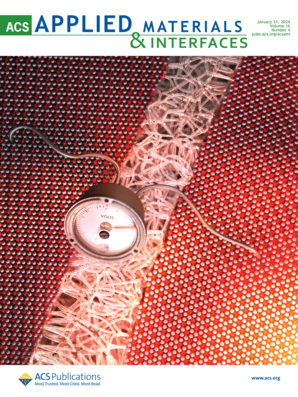2D-Seed-Induced Crystallization Strategy Contributes to Blade-Coating FAPbI3-Based Perovskite Solar Cells.
IF 8.3
2区 材料科学
Q1 MATERIALS SCIENCE, MULTIDISCIPLINARY
引用次数: 0
Abstract
Formamidinium lead iodide (FAPbI3)-based perovskites are promising photoabsorber materials owing to their optimal bandgap and excellent photothermal stability. However, their complex crystallization behavior during blade-coating presents challenges for scalable fabrication, leading to poor perovskite film morphology and uniformity, which adversely affect the performance and stability of perovskite solar cells (PSCs). Herein, a two-dimensional (2D) perovskite seed layer was introduced onto the SnO2 electron transport layer within a conventional n-i-p device architecture. This seed layer was employed to provide heterogeneous nucleation sites for and to induce the bottom-up-oriented growth of [PbI6]4- octahedra, thereby facilitating the formation of the photoactive α-FAPbI3 phase with enhanced crystallinity and film uniformity. As a result, PSCs with an active area of 2.5 × 2.5 cm2 were fabricated, achieving a power conversion efficiency (PCE) of 22.03% and an open-circuit voltage (VOC) of 1.10 V. Furthermore, over 80% of the initial efficiency was retained after 2000 h of ambient storage (relative humidity ≈ 5%, temperature ≈ 25 °C) without encapsulation, indicating excellent long-term stability. Through this approach, a viable and scalable pathway has been established for the fabrication of high-quality α-FAPbI3 films, offering significant potential for the advancement of efficient and stable PSCs.2d种子诱导结晶策略有助于叶片涂层fapbi3基钙钛矿太阳能电池。
基于碘化甲醛铅(FAPbI3)的钙钛矿具有良好的带隙和良好的光热稳定性,是一种很有前途的光吸收材料。然而,它们在叶片涂层过程中复杂的结晶行为给可扩展制造带来了挑战,导致钙钛矿薄膜形态和均匀性差,这对钙钛矿太阳能电池(PSCs)的性能和稳定性产生不利影响。在此,在传统的n-i-p器件结构中,在SnO2电子传输层上引入了二维(2D)钙钛矿种子层。利用该种子层为[PbI6]4-八面体提供非均相成核位点并诱导其自下而上生长,从而促进形成结晶度和膜均匀性增强的光活性α-FAPbI3相。结果表明,制备的PSCs的有效面积为2.5 × 2.5 cm2,功率转换效率(PCE)为22.03%,开路电压(VOC)为1.10 V。此外,在没有封装的环境下(相对湿度≈5%,温度≈25°C)储存2000 h后,仍能保持80%以上的初始效率,显示出优异的长期稳定性。通过这种方法,建立了一种可行且可扩展的制备高质量α-FAPbI3薄膜的途径,为高效稳定的psc的发展提供了巨大的潜力。
本文章由计算机程序翻译,如有差异,请以英文原文为准。
求助全文
约1分钟内获得全文
求助全文
来源期刊

ACS Applied Materials & Interfaces
工程技术-材料科学:综合
CiteScore
16.00
自引率
6.30%
发文量
4978
审稿时长
1.8 months
期刊介绍:
ACS Applied Materials & Interfaces is a leading interdisciplinary journal that brings together chemists, engineers, physicists, and biologists to explore the development and utilization of newly-discovered materials and interfacial processes for specific applications. Our journal has experienced remarkable growth since its establishment in 2009, both in terms of the number of articles published and the impact of the research showcased. We are proud to foster a truly global community, with the majority of published articles originating from outside the United States, reflecting the rapid growth of applied research worldwide.
 求助内容:
求助内容: 应助结果提醒方式:
应助结果提醒方式:


